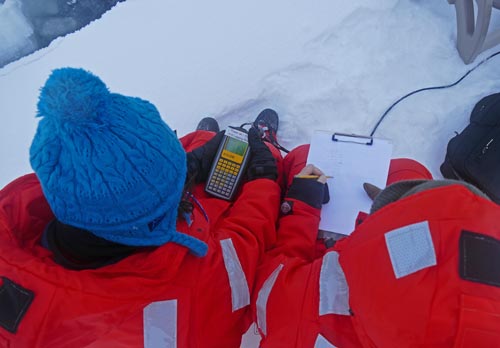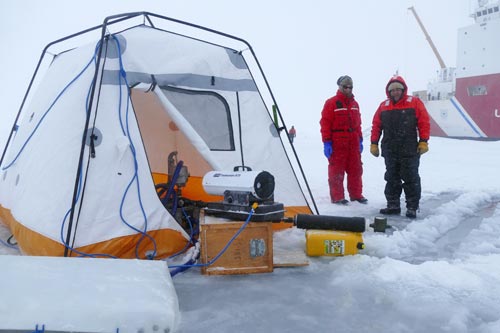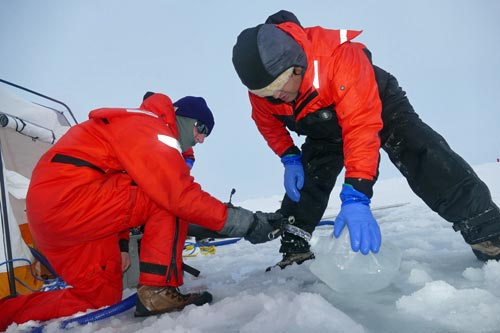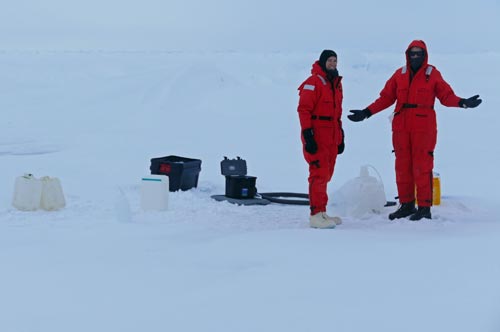Cruise Day 38
Speed 0 knots (kts) (on station)
Course n/a
Location Alpha Ridge, ~292 nautical miles south of N. Pole
Depth 2260 m
GO DEEPER DISCUSSION: (see previous journal for the questions.)
Did you get the riddle? H, I, J, K, L, M, N, O
Answer: H to O…
H2O…
Water!
TODAY’S JOURNAL:
We snugged in for our cruise’s second super station at about 1am this morning, and sampling operations have been happening non-stop since. If the schedule holds, we will transition from shipboard sampling to another ice station in the early hours tomorrow morning. We’re working in mid-depth waters over the Alpha Ridge, which separates the Makarov Basin to the north from the larger Canada Basin to the south.
At yesterday’s ice station, I was able to visit with several groups conducting different types of sampling. One new aspect at this ice station was a nearby open lead that allowed a team led by Chris Measures, Professor from the University of Hawaii, to sample water from the ice’s edge. Mariko Hatta, a research associate from the University of Hawaii, along with Andrew Barna from the Scripps Institution of Oceanography and Johna Winters from the Oregon State University, completed the team. They were interested in seeing how water at ice edges might compare with our other sampling areas. It was pretty cold with a cutting wind chill around 0°F, which gave them trouble with their pump system freezing. They’ve re-tooled the system to better protect it from the cold and plan to try the sampling again tomorrow, if a suitably safe lead can be found near the ice station.
 Chris Measures, Mariko Hatta, Johna Winters, and Andrew Barna deploy a portable CTD at the ice edge to profile the upper water column prior to sampling.
Chris Measures, Mariko Hatta, Johna Winters, and Andrew Barna deploy a portable CTD at the ice edge to profile the upper water column prior to sampling.
 Mariko Hatta and Johna Winters record data from the water column at an open lead in the ice pack.
Mariko Hatta and Johna Winters record data from the water column at an open lead in the ice pack.
 A lovely crop of frost flowers sprouts from new ice in a lead between thick ice floes.
A lovely crop of frost flowers sprouts from new ice in a lead between thick ice floes.
The beryllium pumping team also had difficulty with their pump freezing but employed a new plan after running into this situation earlier in the cruise. They moved their excess hose and pump into an Arctic Oven tent (a very heavy-duty tent designed for polar work), and propped an electric-ignition, diesel-fueled heater at the pump unit inside. Once this was all rigged up they didn’t have any more trouble with their lines freezing, and it was a great place to warm up chilly fingers!
 Dave Kadko and Paul Aguilar preside over beryllium pumping using an Arctic Oven tent warmed by a portable heater to avoid freezing up their pump and hoses.
Dave Kadko and Paul Aguilar preside over beryllium pumping using an Arctic Oven tent warmed by a portable heater to avoid freezing up their pump and hoses.
 Mark Stephens and Paul Aguilar collect a water sample that will go back aboard for radiometric isotope analysis.
Mark Stephens and Paul Aguilar collect a water sample that will go back aboard for radiometric isotope analysis.
Bill Landing (Co-chief Scientist & Professor at Florida State University) and Chris Marsay (Post-doctoral Research Associate at Skidaway Institute of Oceanography) found a frozen-over melt pond to sample. Melt ponds are formed on the surface of sea ice in the summer, but don’t get all of the way through the ice. In this regard they collect melted snow and surface ice, water quite distinct from seawater or even water from deeper in the ice floe. They are a little tricky to find up here now that they are frozen over and snow covered, but look like flat, slightly lower areas in the ice. To sample melt ponds, the team drills through the few inches of ice covering the melt pond and uses a battery-powered pump to fill sample containers which are subsequently brought back to the ship for study.
 Bill Landing and Chris Marsay sample water from a frozen-over melt pond atop the sea ice.
Bill Landing and Chris Marsay sample water from a frozen-over melt pond atop the sea ice.
Tim Kenna (Research Scientist at the Lamont-Doherty Earth Observatory) and Alison Agather (doctoral student at Wright State University) gathered snow samples that several different teams are interested in studying, and the teams characterizing the sea ice and collecting trace-metal clean water, snow, and ice conducted their work as well on the expedition’s 4th ice station.
 Tim Kenna and Alison Agather collect and bag up snow samples to bring back aboard for subsequent analysis.
Tim Kenna and Alison Agather collect and bag up snow samples to bring back aboard for subsequent analysis.
 At each ice station Kyle Dilliplaine conducts ice characterization studies, here assisted by Joe Gum, Kyle McQuiggan, and Bill Schmoker. Photo by Petty Officer 2nd Class Cory Mendenhall.
At each ice station Kyle Dilliplaine conducts ice characterization studies, here assisted by Joe Gum, Kyle McQuiggan, and Bill Schmoker. Photo by Petty Officer 2nd Class Cory Mendenhall.
GO DEEPER!
Why is everyone wearing pretty much the same outfit in each picture?
Aloft Con web cam updated every hour
Healy Track
That's all for now. Best- Bill

